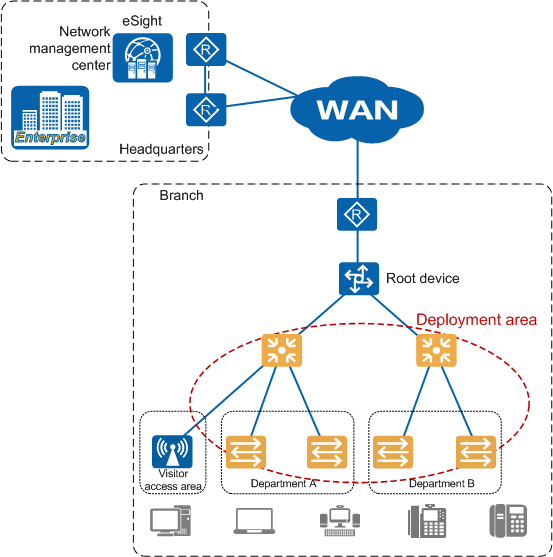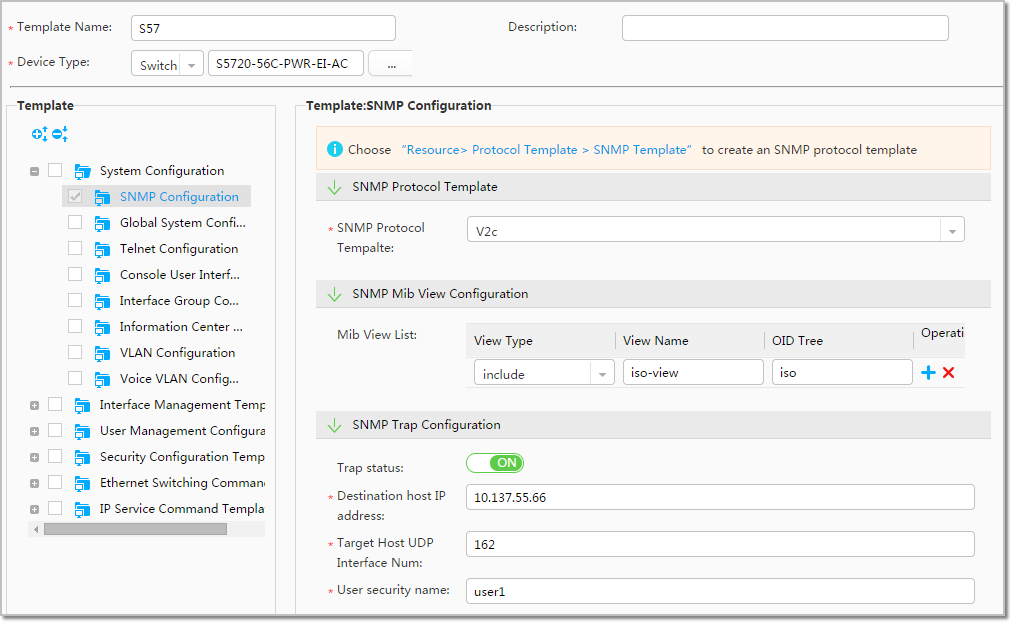Example for Implementing MAC/ESN-based Zero Touch Provisioning
Prerequisites
- A root device has been added to eSight for management and can communicate normally with eSight through SNMP and Telnet.
- A DHCP server has been configured and uses the root device as a gateway.
- Input or output is not allowed on Console interfaces during zero touch provisioning.
- The device software package, license file, and patch file have been prepared and uploaded to eSight. If not, choose to upload the files.
Networking Requirements
On the wired campus network of company M, there are lots of devices at the aggregation and access layers. The configuration is complex. Jack, the network administrator of the company, requires that eSight implement unified MAC/ESN-based Zero Touch Provisioning for aggregation and access devices to reduce management cost.
In the following figure, the red circle specifies the devices to be deployed. The eSight software version is V300R003C20.

Configuration Roadmap
- Select a root device and configure VLAN 1 as a pass VLAN on the root device.
- Configure the root device as a DHCP server.
- Plan provisioning files for devices.
- Power on the devices and manually record MAC addresses/ESNs of the devices.
- Match the MAC addresses/ESNs with provisioning files.
- Trigger provisioning. After the devices upload the provisioning files, the provisioning is complete.
Data Plan
Device Type |
Device IP Address |
Downstream Port 1 |
Downstream Port 2 |
|---|---|---|---|
S5720–56C-PWR-HI-AC |
10.137.58.61 |
GE0/0/1 |
GE0/0/2 |
Device Type |
IP Address |
Upstream Port |
Downstream Port 1 |
Downstream Port 2 |
|---|---|---|---|---|
S5720–32C-HI-24S-AC |
10.137.58.1 |
GE0/0/1 |
GE0/0/2 |
GE0/0/3 |
S5720–32C-HI-24S-AC |
10.137.58.2 |
GE0/0/1 |
GE0/0/2 |
GE0/0/3 |
Device Type |
IP Address |
Port |
|---|---|---|
S2750–28TP-EI-AC |
10.137.58.3 |
GE0/0/1 |
S2750–28TP-EI-AC |
10.137.58.4 |
GE0/0/1 |
S2750–28TP-EI-AC |
10.137.58.5 |
GE0/0/1 |
S2750–28TP-EI-AC |
10.137.58.62 |
GE0/0/1 |
Location |
IP Address |
ESN |
Device Type |
Device Model |
Configuration File |
Other Files |
|---|---|---|---|---|---|---|
Aggregation 1 |
00E0-FC12-AA4B |
— |
S5700 |
S5700-28C-HI |
N1.zip |
S5700.cc |
Aggregation 2 |
00E0-FC12-AA5B |
— |
S5700 |
S5700-28C-HI |
N2.zip |
S5700.cc |
Access 1 |
— |
AAC1223431 |
S2700 |
S2750-28TP-EI-AC |
N3.zip |
S2700.cc |
Access 2 |
— |
AAC1223432 |
S2700 |
S2750-28TP-EI-AC |
N4.zip |
S2700.cc |
Access 3 |
— |
BAC1223433 |
S2700 |
S2750-28TP-EI-AC |
N5.zip |
S2700.cc |
Access 4 |
— |
BAC1223436 |
S2700 |
S2750-28TP-EI-AC |
N6.zip |
S2700.cc |
Procedure
- Specify VLAN 1 as a pass VLAN on the root device (the configuration is not provided here).
- Configure the root device as a DHCP server. For details, see Configuring a DHCP Server.
- Prepare configuration files for devices to be deployed.
- Connect cables of devices to be deployed and power on them. Manually record MAC addresses/ESNs, locations, and models of the devices into an Excel file.

- Match the configuration file, software package, patch file, and license file with the devices to be deployed.
- Trigger provisioning and restart the switches after they download corresponding files.
- Select the created manual provisioning task and click Start.
- Click Active. The devices are restarted and download the latest provisioning files. The entire provisioning task delivery then is complete.



